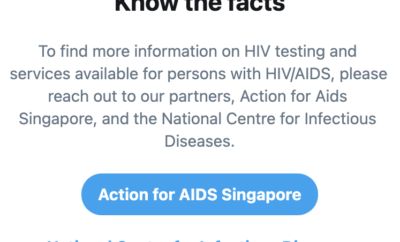
Health x Wellness
Is it possible to end HIV in Singapore?
According to the recent Vital Signs Report by the US Centre for Disease Control and Prevention, most new infections are transmitted by just 40% of people infected with HIV. Shockingly, every one out of seven persons with HIV are not aware that they have the condition.
Many healthcare providers, and related communities face challenges across several fronts. What can they do to prevent the spread of HIV, and can they do so without unintended impact to these communities? Where and how can individuals test if they are infected, without fearing being stigmatised and discriminated in their social life and workplace?
We spoke with Dr. Jonathan Ti, from Dr Tan & Partners, who is part of the team developing guidelines for the Blueprint to end HIV in Singapore.
The Active Age (AA): What is the “Blueprint to End HIV in Singapore” guideline/committee about?
Dr. Jonathan Ti (JT): In 2014, the Joint United Nations Programme on HIV/AIDS (UNAIDS) and partners launched the 90–90–90 targets; the aim was to diagnose 90% of all HIV-positive persons, provide antiretroviral therapy (ART) for 90% of those diagnosed, and achieve viral suppression for 90% of those treated by 2020.
The aim of our committee is to produce a living document that will outline the targets, efforts, and resources needed to reach these ambitious goals and end HIV transmission in Singapore. This blueprint will serve as a basis to strengthen the national HIV response through a combination of clinical and community-led efforts, technology, and data, research, and evaluation. The group comprises of doctors, researchers, administrators, and advocates from various public and private sector groups, including the DSC (Department of Sexually Transmitted Infections Control), NCID (National Centre for Infectious Diseases), AfA (Action for AIDS), Project X, and Anonymous HIV Testing Sites such as DTAP @Robertson where I am currently practicing.
AA: What are some of the ideas and concepts being considered and how will this support or lessen the incidence of PLHIV (People Living with HIV)?
JT: Ending HIV transmission in Singapore will of course require significant efforts across a broad range of different aspects. To this end, we have divided into sub sectors which are focused on various issues, such as transmission in the MSM population (men who have sex with men), transmission in heterosexual men, transmission in commercial sex workers, dealing with sitgma and discrimination, as well as several other aspects of HIV prevention.
I am co-leading the subsector on the Community-Based Medical Workforce, with key objectives of building the capacity of the HIV community-based medical workforce in Singapore through developing policies, guidelines and backbone resources to focus on expanding HIV anonymous testing facilities, education and outreach, expanding access to HIV PrEP (Pre-Exposure Prophylaxis), and supporting treatment for PLHIV.
Currently, we feel that there is an inadequate number of medical clinics designated as anonymous testing sites, and an inadequate number that are able to manage and offer HIV PrEP and that are able to co-manage PLHIV with their specialists. We want to establish and provide formal, structured training for private medical practitioners to provide HIV testing and prevention services to their patients, expanding access and ensuring a uniform level of competency, messaging and quality of care.
At the same time, we want to improve education and public awareness on HIV testing and prevention services in the community. This will help to reduce stigma and discrimination for PLHIV and other marginalised groups, improving rates of testing and adherence to follow up and treatment.
AA: What has been a shift in lifestyle in men’s sexual health matters over the past decade? What can we attribute this shift to, and what might be a possible outcome?
JT: With the rise of social networking and dating apps, making connections online and meeting new people has become easier than ever before. The Internet has provided society with the “3 A’s” – Availability, Accessibility, and in certain cases, Anonymity. We are no longer living in our parents’ or grandparents’ world where meeting or marrying your high-school sweetheart is the norm; we are now travelling more, meeting more people, and should we wish, involving ourselves in more sexual relationships and encounters.
With higher numbers of sexual partners, there is of course a potential increase in risky sexual behavior and sexually transmitted infections. We are also progressing – albeit slowly – on the front of LGBTQ acceptance and openness; improved education and a shift in cultural values serves to reduce stigma and discrimination, allowing individuals to come forward and speak to their friends, families, and doctors for sexual health advice and testing.
Although STD risk may be increased with this shift in lifestyle, the good news is that we are also seeing more awareness and accessibility of services catering to sexual health and male health issues. For instance, with regards to Anonymous HIV Testing Sites in Singapore – DTAP @Robertson was the first and only private medical clinic performing such tests when it opened in 2007, but we now have around 10 designated ATS clinics around the country. Again, part of our mission with the Blueprint to End HIV committee is to further expand the number of clinics and doctors trained to deal with HIV and STD testing, prevention (e.g. PrEP), and treatment.
Apart from sexual matters, we are also seeing more men who are prioritising their fitness, nutrition, and overall quality of life through their silver years. Part of this healthy lifestyle entails having a good relationship with a primary healthcare provider who can advise on the necessary health screening tests, and potential need for preventive or supplementary therapies, including hormone replacement therapy, nutritional guidance, and even mental health counselling.
We hope that having more primary care providers who can cater to men’s health and lifestyle issues will encourage all of us to live longer, healthier, and more fulfilling lives.









